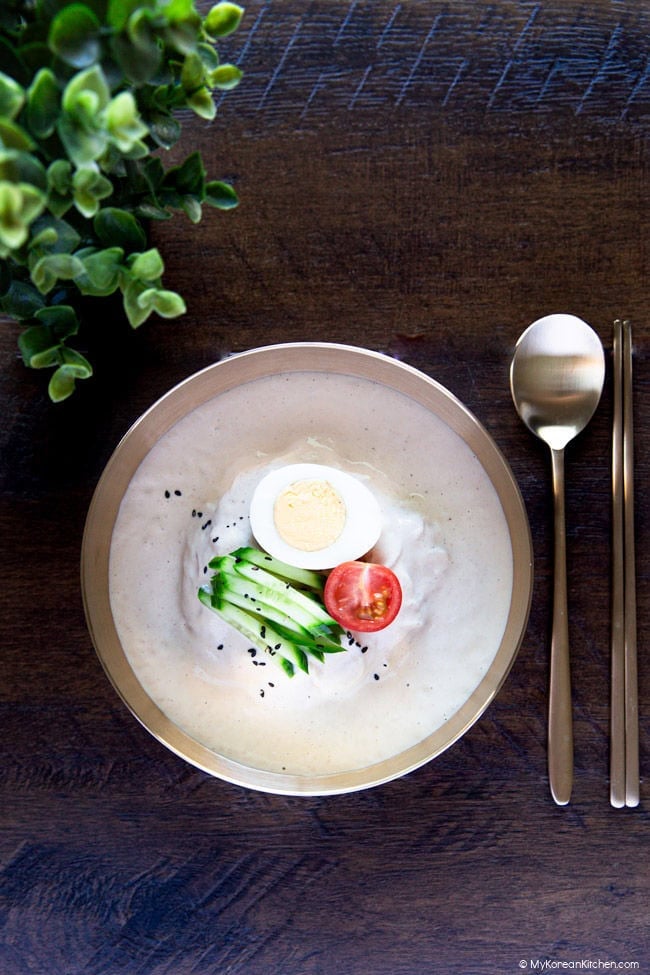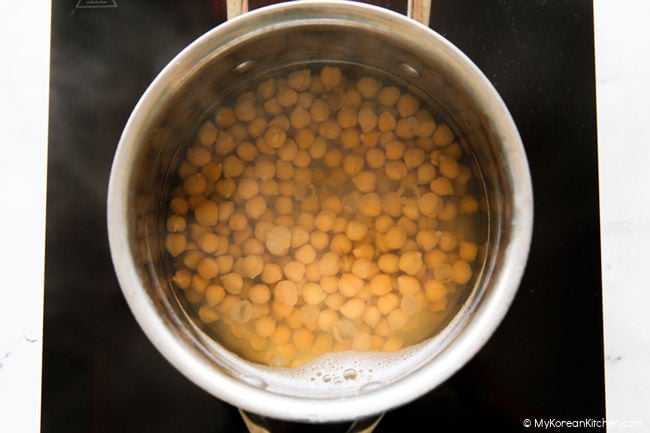Uncover the refreshing attraction of Kongguksu (콩국수), a creamy and nutty Korean noodle dish that’s excellent for cooling down on a heat day.
On this recipe, I’ll information you thru creating a conventional model of Kongguksu, full with recommendations on the right way to incorporate soybean powder and chickpeas as flavorful options to soybeans. Let’s make this beloved Korean traditional collectively and luxuriate in its finest taste and texture!

Why Make Kongguksu at Dwelling
Kongguksu, often known as Kong-guksu or soy milk noodles, is a creamy, nutty, and savory delight that serves as the proper antidote to scorching sizzling days. This refreshing noodle soup not solely offers a cool and satisfying escape from the warmth but in addition delivers a robust dietary increase.
Wealthy in plant-based protein and important vitamins, it offers a lightweight but filling meal that nourishes and energizes. Whereas many Korean summer time noodles are celebrated for his or her spicy and daring flavors, kongguksu affords a contrasting expertise with its delicate, calming, and soothing style, making it an excellent alternative for a relaxed and refreshing meal.


Suggestions for the Greatest Kongguksu
Soybeans and Alternate options
Think about using natural soybeans on your recipes. Apparently, I had some bother discovering dried soybeans at my native Korean and non-Korean grocery shops. Luckily, I used to be in a position to organize them from Amazon, and so they labored completely. For kongguksu, you’ll have to soak the soybeans in a single day or for a minimum of 8 hours to rehydrate them. Nonetheless, in case you use sizzling boiling water, 1 hour is adequate.
If soybeans aren’t your factor, chickpeas are an excellent substitute, although they’ve a milder taste. Personally, I desire the style of Kongguksu made with soybeans. You should use both dried or canned chickpeas, each of which work nicely. Canned chickpeas are an awesome time-saver since they don’t want soaking.


Alternatively, you need to use soybean powder (konggaru, 콩가루) from a Korean grocer. Not all Korean grocers carry it, however after they do, it’s typically prepared to make use of for Kongguksu and will embody different components like floor nuts and a little bit of salt.
To organize, combine and dissolve the powder in water or milk. Then, merely serve it over boiled skinny wheat noodles like somen (somyeon, 소면) and high along with your alternative of toppings (see the options within the components part beneath). I discover that utilizing milk provides a richer, nuttier taste than water, so I like to recommend it. Nonetheless, the soybean powder has fairly an intense nutty taste by itself, so I don’t really feel the necessity to use soy milk.


For the most effective outcomes, use 1/2 cup of soybean powder with 1 cup of full cream milk and 1/4 teaspoon of high-quality sea salt. Regardless that the soybean powder already comprises salt, you’ll hardly discover it as soon as the noodles are added, so that you may need to sprinkle in somewhat further.
Soy Milk and Alternate options
There are a few methods to make the soup for this recipe, and I feel natural soy milk works finest when utilizing precise soybeans for a deeper taste. Nonetheless, in case you don’t have soy milk or desire to not use it, you need to use the water from boiling soybeans or common milk as an alternative. Simply understand that these options received’t be as wealthy and flavorful because the soy milk model and will give your soup a much less interesting look.


Substances for Kongguksu
- 1/2 cup natural dried soybeans (or dried chickpeas, or one 425g can of chickpeas)
- 5 cups water
- 3/4 tsp high-quality sea salt, divided (1/4 tsp for boiling + 1/2 tsp for mixing)
- 1 Tbsp sesame seeds
- 1 Tbsp pine nuts
- 1 Tbsp walnuts
- 200g / 7.1 ounces somen noodles (skinny wheat noodles)
- 2 cup unsweetened natural soy milk, chilled
- 1 tsp sugar, uncooked
- 50g / 1.8 ounces cucumber (Lebanese or English), julienned
- 1-2 cherry tomatoes, halved
- 1-2 eggs, boiled, halved
* 1 Tbsp = 15 ml, 1 cup = 250 ml
Methods to Make Kongguksu
1. Put together soybeans.
(1) Boil some water, then soak dry soybeans in it for an hour. Alternatively, you possibly can allow them to sit in room temperature water in a single day, or for a minimum of 6-8 hours.


(2) Drain the water and wash the soybeans beneath operating water. Take away any free shells that come off.
(3) In a pot, combine soybeans with water and 1/4 teaspoon of salt. Boil over medium warmth for quarter-hour, skimming off any foam with a spoon. Observe: The following three pictures present chickpeas.


(4) Scale back the warmth to medium-low and boil for one more 40-45 minutes till the soybeans are absolutely cooked.


(5) Rinse the soybeans beneath operating water and take away any remaining shells. Set them apart. 1/2 cup (96g / 3.4 ounces) of dry soybeans will yield roughly 1 cup (183g / 6.5 ounces) after boiling.


Whereas the soybeans are boiling, use this time to get the opposite components prepared.
2. With a mortar and pestle, crush the sesame seeds, pine nuts, and walnuts till they’re finely floor. This hands-on technique is vital for a clean texture since these nuts and seeds don’t mix nicely in a blender, serving to them combine completely into the soup.


3. Prepare dinner the somen noodles in boiling water in keeping with the bundle directions, usually for 3-5 minutes. As soon as cooked, drain the noodles and rinse them beneath chilly operating water to chill.


4. Place the ready soybeans, soy milk, floor nut combination from step 2, sugar, and 1/2 teaspoon of salt right into a blender. Mix every little thing collectively till the combination is clean and nicely mixed.


5. Switch the cooked somen to a serving bowl and pour the soy milk combination generously over the noodles. Garnish with cucumber slices, cherry tomatoes, and a halved boiled egg.


6. Serve the noodles with some kimchi. Summer season varieties like cucumber kimchi or younger radish kimchi complement the dish superbly.




Different Chilly Korean Noodle Recipes You May Like
These dishes provide a refreshing twist with their vibrant flavors and cooling components—simply excellent for summertime!
Love Korean meals? Discover our web site for extra genuine Korean recipes together with the right way to create a excellent Korean BBQ at residence or different straightforward Korean recipes. Additionally, by no means miss a brand new recipe by subscribing to our e-newsletter, and be a part of us in celebrating Korean delicacies!


Put together soybeans.
-
Soak dry soybeans in boiling water (100°C / 212°F) for an hour. Alternatively, you possibly can allow them to sit in room temperature water in a single day, or for a minimum of 6-8 hours.
-
Drain the water and wash the soybeans beneath operating water. Take away any free shells that come off.
-
In a pot, combine soybeans with water and 1/4 teaspoon of salt. Boil over medium warmth for quarter-hour, skimming off any foam with a spoon. Observe: The following three pictures present chickpeas.
-
Scale back the warmth to medium-low and boil for one more 40-45 minutes till the soybeans are absolutely cooked.
-
Rinse the soybeans beneath operating water and take away any remaining shells. Set them apart. 1/2 cup (96g / 3.4 ounces) of dry soybeans will yield roughly 1 cup (183g / 6.5 ounces) after boiling.
Get the opposite components prepared.
-
With a mortar and pestle, crush the sesame seeds, pine nuts, and walnuts till they’re finely floor. This hands-on technique is vital for a clean texture since these nuts and seeds don’t mix nicely in a blender, serving to them combine completely into the soup.
-
Prepare dinner the somen noodles in boiling water in keeping with the bundle directions, usually for 3-5 minutes. As soon as cooked, drain the noodles and rinse them beneath chilly operating water to chill.
-
Place the ready soybeans, soy milk, floor nut combination from step 2, sugar, and 1/2 teaspoon of salt right into a blender. Mix every little thing collectively till the combination is clean and nicely mixed.
-
Switch the cooked somen to a serving bowl and pour the soy milk combination generously over the noodles. Garnish with cucumber slices, cherry tomatoes, and a halved boiled egg.
-
Serve the noodles with some kimchi. Summer season varieties like cucumber kimchi or younger radish kimchi complement the dish superbly.
Energy: 792kcal | Carbohydrates: 95g | Protein: 44g | Fats: 27g | Saturated Fats: 3g | Polyunsaturated Fats: 13g | Monounsaturated Fats: 6g | Trans Fats: 0.01g | Ldl cholesterol: 82mg | Sodium: 2254mg | Potassium: 1322mg | Fiber: 12g | Sugar: 21g | Vitamin A: 1119IU | Vitamin C: 23mg | Calcium: 539mg | Iron: 10mg
The diet info proven is an estimate offered by a web-based diet calculator. It shouldn’t be thought of an alternative choice to an expert nutritionist’s recommendation.


